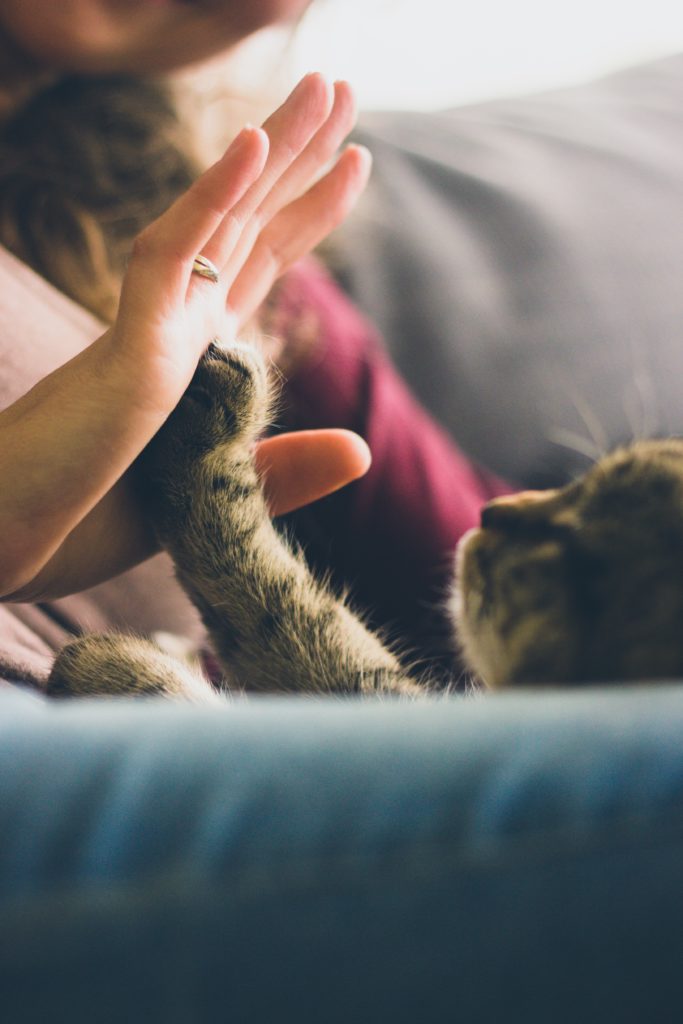
We’re not sure what exactly started the feud between the Hatfields and the McCoys, but it may well have been an argument about cat food. No matter how far veterinary medicine advances or how much we enhance our understanding of our pet’s nutritional needs, the debate over dry versus wet cat food rages on. In truth, both are acceptable options and you need not feel shame or guilt if you feed your pet dry cat food. Here is the simple truth about dry cat food and what you need to know when choosing your feline’s diet.
You are the target.
Your cat doesn’t go to the grocery store. When creating commercials food makers are appealing to your senses, not your pet’s. Buzzwords like grain-free, all natural and raw mean nothing to your cat, who honestly don’t care if the first ingredient in his food is corn meal or de-boned white meat chicken. Ignore the hype and focus on facts when picking your cat’s diet.
Don’t fall for the outdoor diet myth.
To entice you into buying wet or fresh refrigerated food, cat food manufacturers like to remind you that your cat would never eat dry kibble if he were living in the wild. Instead, he would eat only the fresh meat that he hunted and killed himself. What these carnivorous purists neglect to mention is that your cat would actually be eating his entire catch – not just the meat. According to Dr. Richard Hill of the University of Florida’s College of Veterinary Medicine, meat alone doesn’t contain all of the amino acids, minerals and vitamins a healthy cat needs. It may, however, contain harmful bacteria.
Indoor cats do eat differently than their outdoor counterparts, but they also live much longer. Indoor cats typically live 9 to 15 years while outdoor cats live only 4 to 5 years. Diet and nutrition play a role in the longevity of indoor cats, so don’t be fooled into thinking your indoor cat’s diet is lacking if it isn’t full of moist meat morsels.
Cats are obligatory carnivores, however, so please don’t attempt to turn your pet into a vegetarian.
Dry cat food offers several advantages.
Pet parents choose the foods they do for a number of different reasons, and there are some compelling benefits to dry cat food. One is cost. Dry pet food costs less than canned, but that doesn’t mean it’s lacking in quality. In fact, a high-quality dry food can provide more nutritional value than poor quality canned food and may do so at a fraction of the price.
Dry cat food is also extremely easy to store and takes up less space in your pantry than individual cans. It also makes cleanup after feeding time much easier. Wet cat food requires washing of the bowls and feeding area after every meal and may require you to clean off your kitty as well if he is a messy eater. Some dry foods are formulated to reduce tartar and promote oral health, as well, potentially minimizing the number of dental hygiene visits your cat requires.
Value nutrients over ingredients.
What is in your cat’s food matters, but what she gets out of it matters more. It doesn’t matter if your cat gets a certain nutrient from corn or another grain. It’s far more important that she gets enough of the nutrient. Cat food manufacturers, however, will try and convince you that one ingredient is better than another, even when it’s not true. Focus more on what your cat is getting out of her food, not how she is getting it.
Think of feeding your cat like feeding your children in this regard. It’s important to make sure that your child’s growing bones receive adequate amounts of calcium. Milk is an excellent source of calcium, but so is cheese. If your child refuses to drink milk but absolutely loves cheese, the easiest and smartest course of action may be to fill the fridge with cheese rather than fighting over milk.
The same is true for your cat. It is more important to focus on meeting your cat’s nutritional needs than worrying about how you’re getting there. So long as the food contains no harmful ingredients, there is no reason to worry about whether meat or grain is the first listed ingredient.
So, what should I look for?
When you strip away the hype and the buzzwords, what you need is a nutritionally sound food your cat is willing to eat. To find it, choose foods that contain an American Feed Control Officials (AAFCO) feed trial statement. This helps ensure that the food you are buying has been tested and meets recommended nutritional feed standards.
You’ll also want to dig a bit deeper and look for the words “manufactured by” on your cat food bag. You don’t want a food that was made for, distributed for or manufactured for someone else. Quality pet food companies generally opt to manufacture products themselves so they can maintain strict control over the ingredients and manufacturing processes used. It is also best to purchase foods made in the United States that adhere to our national ingredient and labeling laws.
Remember your greatest ally.
When thinking about your cat’s dietary needs, remember to talk to your veterinarian. It’s easy to think of the vet only when there is something wrong with your pet, but he is a great source of wellness information, too. Your vet is also in tune with your cat’s special needs and can help you deal with food allergies, weight issues, dental problems and other issues that may impact your cat’s specific dietary needs.
Source: Read Full Article
